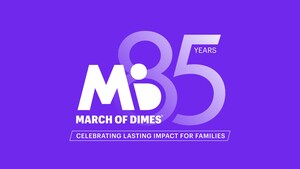Discovery of genes linked to preterm birth in landmark study
Study based on data from more than 50,000 women, published today in The New England Journal of Medicine, could lead to new ways to prevent leading cause of infant mortality
CINCINNATI, Sept. 6, 2017 /PRNewswire-USNewswire/ -- A massive DNA analysis of pregnant women has identified six gene regions that influence the length of pregnancy and the timing of birth. The findings, published today in the New England Journal of Medicine, may lead to new ways to prevent preterm birth and its consequences—the leading cause of death among children under age 5 worldwide.
The study, coordinated by Louis Muglia, MD, PhD, co-director of the Perinatal Institute at Cincinnati Children's and principal investigator of the March of Dimes Prematurity Research Center--Ohio Collaborative, together with Bo Jacobsson, MD, PhD, of Sahlgrenska Academy, University of Gothenburg, Sweden and the Norwegian Institute of Public Health, Oslo, involved data from more than 50,000 women. The globe-spanning team included first author Ge Zhang, MD, PhD, of the Division of Human Genetics at Cincinnati Children's, along with researchers from Norway, Denmark, Finland, Sweden, Yale University, University of Iowa, and the genetic testing company 23andMe. Vital funding was provided by the March of Dimes, the National Institutes of Health, The Research Council of Norway, Swedish Research Council and the Bill & Melinda Gates Foundation.
The March of Dimes Prematurity Research Center--Ohio Collaborative, launched in 2013, is responsible for the gene identification component of the network of five Prematurity Research Centers nationwide established by the March of Dimes to identify the unknown causes of preterm birth. Because preterm birth is a complex disorder with many possible causes, other Prematurity Research Centers are charged with exploring different aspects of preterm birth and how to prevent it. The centers work together on complementary investigations and share data and biosamples to accelerate progress.
WHAT IS PRETERM BIRTH?
Preterm birth is defined as any birth occurring before 37 weeks of pregnancy. In addition to the risk of death, babies who survive an early birth often face serious, lifelong health problems, including chronic lung disease, vision and hearing impairment, cerebral palsy, and neurodevelopmental disabilities. The scientific world has been hunting for the causes of preterm birth for decades.
LARGE-SCALE PROJECT REQUIRED LARGE-SCALE COLLABORATION
"We have known for a long time that preterm birth is a combination of genetic and environmental factors. Previous research has suggested that about 30 to 40 percent of the risk for preterm birth is linked to genetic factors. This new study is the first to provide robust information as to what some of those genetic factors actually are," says Dr. Muglia.
"This is a very exciting discovery that can be expected to lead to the development of new treatments to prevent pregnant women from going into labor too soon and to give more babies a healthy start in life," says Stacey D. Stewart, president of the March of Dimes. She noted that identifying the biologic causes of preterm birth will be necessary for the United States to reach the March of Dimes goal to reduce the preterm birth rate to 5.5 percent by 2030.
Dr. Muglia notes that this study assembled extensive genomic data from at least five times as many pregnant women than had been gathered by any previous study of pregnancy and preterm birth. The findings are based heavily on data from more than 44,000 women who provided saliva samples to 23andMe. These women also answered questions about their past pregnancies and agreed that their genetic information could be analyzed, anonymously, for science.
The other crucial reference data set involved more than 8,000 Nordic women with the assistance of the Mother Child Cohort of Norway (MoBa); The Finnish Birth Cohort (FIN); and the Danish National Birth Cohort (DNBC).
"In the past year, there have been several successful large genome-wide association studies of reproductive behaviors; in that context, I think this study is particularly important because of the immediate clinical relevance of gestational timing," says David Hinds, PhD, 23andMe Principal Scientist and Statistical Geneticist, who helped to co-author the paper. "This work shows that genetics can improve our understanding of variation in timing."
"These are exciting findings that could play a key role in reducing newborn deaths and giving every child the chance to grow up smart and strong," says Trevor Mundel, President of the Global Health Division of the Bill & Melinda Gates Foundation. "Not only did the study reveal several genes linked to pre-term birth, it also identified a simple, low-cost solution – selenium supplements for expectant mothers – that, if confirmed, could save thousands of lives. It's a great example of the power of public-private partnership."
WHAT DO THESE DISCOVERIES MEAN?
Today's breakthrough findings lead to several key implications:
- This is a beginning point. The six gene areas identified by the project serve as a launching platform for deeper research, some of which has already begun. Potential diagnostic tests, new medications, improved dietary supplements or other changes that could help more women have full-term pregnancies will require several more years of study, the authors say.
- One of the gene areas identified suggests that cells within the lining of the uterus play a larger-than-expected role in the length of pregnancy, which in turn provides a new target for medications to help prevent preterm birth.
- Another newly identified gene area raises important questions about how a lack of selenium—a common dietary mineral found in some nuts, certain green vegetables, liver and other meats—might affect preterm birth risk. People living in regions with low selenium in soil and diet, and people in the U.S. who live in low-income "food deserts" are most at risk of having a lack of selenium in their diets.
WHAT'S NEXT?
In the months and years to come, much more research will be conducted to build upon today's findings.
For example, work is underway to launch studies in Africa and Asia to determine how precisely the gene associations found in this study apply to non-European populations.
Planning work has started to conduct more-specific testing of selenium levels in pregnant women in low-income nations and areas within the United States.
Dr. Muglia noted that today's findings will also be part of a March of Dimes Prematurity Research Center database that will allow researchers to study the importance of these genes not only in isolation but in context with other potential factors in preterm birth now under investigation, including:
- the microbiome and inflammation/infection;
- structural integrity of cervix and uterine pacemakers that drive contractions;
- fetal-maternal signaling to initiate labor;
- nutrition and mitochondria;
- the molecular basis of social determinants of preterm birth.
The March of Dimes Prematurity Research Center--Ohio Collaborative partners are Cincinnati Children's Hospital Medical Center, University of Cincinnati, The Ohio State University, Nationwide Children's Hospital, Mount Carmel Health System, Case Western Reserve University, University MacDonald Women's Hospital and Rainbow Babies & Children's Hospital, and the MetroHealth System.
The other centers are located at Stanford University School of Medicine; Washington University in St. Louis; University of Pennsylvania Perelman School of Medicine; and University of Chicago-Northwestern University-Duke University.
CITATION
Zhang, G, Feenstra B, Bacelis J, et al. Genetic Associations with Gestational Duration and Spontaneous Preterm Birth. N Engl J Med. DOI: 10.1056/NEJMoa1612665.
The paper appears free online beginning at 5:00 p.m. Eastern time, Wednesday, September 6 and will be in the September 21 printed issue of the New England Journal of Medicine.
THANK YOU TO THESE SUPPORTING ORGANIZATIONS
Major funding and collaboration for the study were provided by the March of Dimes, White Plains, NY; Cincinnati Children's Hospital Medical Center; 23andMe, Inc., Mountain View, CA; Bill & Melinda Gates Foundation, Seattle, WA; the National Institute of Child Health and Human Development, Bethesda, MD; The Finnish Birth Cohort (FIN); Mother Child Cohort of Norway (MoBa); and the Danish National Birth Cohort (DNBC).
Other partners in the study in the U.S. included Fifth Third Foundation, Cincinnati; The Broad Institute of MIT and Harvard, Cambridge, MA; Carver College of Medicine, University of Iowa, Iowa City, IA; Massachusetts General Hospital, Boston, MA; Stanford University School of Medicine, Stanford, CA; Wayne State University, Detroit, MI; and Yale University, New Haven, CT.
ABOUT THE MARCH OF DIMES
The March of Dimes is the leading nonprofit organization for pregnancy and baby health. For more than 75 years, moms and babies have benefited from March of Dimes research, education, vaccines, and breakthroughs. For the latest resources and health information, visit our websites marchofdimes.org and nacersano.org. If you have been affected by prematurity or birth defects, visit our shareyourstory.org community to find comfort and support. For detailed national, state and local perinatal statistics, visit peristats.org. You can also find us on Facebook or follow us on Instagram and Twitter.
SOURCE March of Dimes
Related Links
WANT YOUR COMPANY'S NEWS FEATURED ON PRNEWSWIRE.COM?
Newsrooms &
Influencers
Digital Media
Outlets
Journalists
Opted In





Share this article